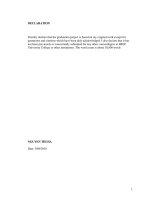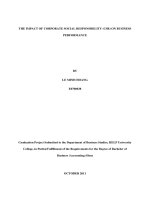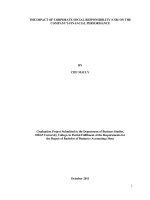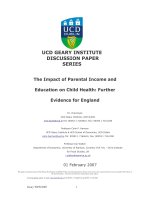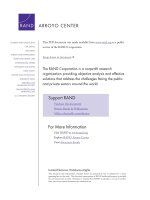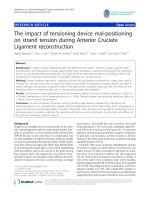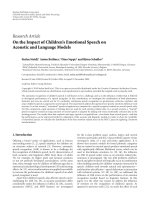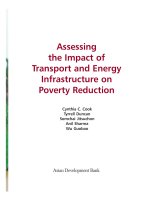The impact of teaching critical thinking skills on reading comprehension m a 60 14 10
Bạn đang xem bản rút gọn của tài liệu. Xem và tải ngay bản đầy đủ của tài liệu tại đây (801.22 KB, 169 trang )
VIETNAM NATIONAL UNIVERSITY – HOCHIMINH CITY
UNIVERSITY OF SOCIAL SCIENCES AND HUMANITIES
FACULTY OF ENGLISH LINGUISTICS AND LITERATURE
THE IMPACT OF TEACHING CRITICAL
THINKING SKILLS ON READING
COMPREHENSION
Submitted to the Faculty of English
Linguistics and Literature
in partial fulfillment of
the Master’s degree in TESOL
By
PHAN THI TRA KHUC
Supervised by
PHO PHUONG DUNG, Ph.D.
HO CHI MINH CITY, JULY 2014
VIETNAM NATIONAL UNIVERSITY – HOCHIMINH CITY
UNIVERSITY OF SOCIAL SCIENCES AND HUMANITIES
FACULTY OF ENGLISH LINGUISTICS AND LITERATURE
THE IMPACT OF TEACHING CRITICAL
THINKING SKILLS ON READING
COMPREHENSION
A thesis submitted to the
Faculty of English Linguistics and Literature
in partial fulfillment of the Master’s degree in TESOL
By
PHAN THI TRA KHUC
Supervised by
PHO PHUONG DUNG, Ph.D.
HO CHI MINH CITY, JULY 2014
STATEMENT OF AUTHORSHIP
I certify that this thesis, entitled “The impact of teaching critical thinking skills on
reading comprehension” is my own work.
This thesis has not been submitted for the award of any degree or diploma in any
other institution.
Ho Chi Minh City, May 25, 2014
Phan Thi Tra Khuc
i
RETENTION AND USE OF THE THESIS
I hereby state that I, Phan Thi Tra Khuc, being the candidate for the
degree of Master of TESOL, accept the requirements of the University relating to
the retention and use of Master’s Theses deposited in the Library.
In terms of these conditions, I agree that the original of my thesis
deposited in the Library should be accessible for the purposes of study and
research, in accordance with the normal conditions established by the Library for
the care, loan or reproduction of theses.
Ho Chi Minh City, May 25, 2014
Phan Thi Tra Khuc
ii
ACKNOWLEDGEMENTS
I would like to express my sincere gratitude to many individuals who
supported me during the implementation of this thesis.
I wish to acknowledge first and foremost my thesis supervisor, Dr. Pho Phuong
Dung for her endless patience reading my drafts over and over again with
extremely great care, her thoughtful comments and her gentle-but-incisive
feedback, without all of which, this thesis would have been impossible. I will
always be thankful for her dedication and support during this thesis work.
I extend heartfelt thanks to Dr. Le Hoang Dung, Dean and Dr. Nguyen Thi Kieu
Thu, former Dean of the Faculty of English and Literature, who have created
favorable conditions for me to pursue the Master’s program and finish my thesis. I
am also deeply grateful to all my teachers in my MA and BA courses for their
instruction and dedication.
I would like to thank my close friend, Ms. Hoang Thi Nhat Tam, who has been
inspiring and motivating both my teaching and my doing research. My special
thanks also go to Ms. Ngo Thi Duyen An and Ms. Trinh Hoang Yen for their
practical guidance and their constant encouragement.
I am greatly indebted to Mr. Truong Hon Huy and Ms. Nguyen Nha Tran for their
willingness to share materials which are necessary for me to accomplish this
thesis.
I, last but not least, would like to dedicate this thesis to my beloved mother and
father, my aunt’s family and my boyfriend. Their love and support were my
greatest source of inspiration and motivation in completing this study.
iii
ABSTRACT
Reading comprehension requires a tight connection with readers’ critical
thinking. However, Vietnamese students are commonly stereotyped as noncritical students; hence, the lack of critical thinking skills is one of the factors
resulting in the poor performance of Vietnamese students in reading
comprehension. This study aims to investigate the effectiveness of explicit
teaching of critical thinking skills on students’ reading comprehension using the
revised Bloom’s taxonomy and examine the attitudes of the experimental students
towards this teaching approach. To this aim, 78 freshmen in the Faculty of
English Linguistics and Literature were invited to participate in this quasiexperimental study. The findings of this study indicate that teaching critical
thinking
skills
works effectively in
promoting
the
students’
reading
comprehension, especially when they respond to reading questions requiring their
understanding and analyzing skills. This approach is also empirically proved to
bring better effects to the students in the low level group. In addition, the results
collected through the questionnaire with follow-up interviews revealed that the
students had positive attitude towards this teaching approach.
iv
CONTENTS
CHAPTER 1
INTRODUCTION ................................................................... 1
1.1 Rationale of the study................................................................................ 1
1.2 Context of the study .................................................................................. 3
1.2.1 The course Language Skills 1A .............................................................. 3
1.2.2 Perceptions of the teachers and students of a reading
comprehension class................................................................................ 5
1.3 Aim of the study........................................................................................ 8
1.4 Research questions .................................................................................... 8
1.5 Significance of the study ........................................................................... 8
1.6 Organization of the study .......................................................................... 9
CHAPTER 2
LITERATURE REVIEW ..................................................... 10
2.1 Theoretical concepts................................................................................ 10
2.1.1 Reading comprehension ....................................................................... 10
2.1.2 The relationship between reading comprehension and critical
thinking skills ....................................................................................... 12
2.1.3 Critical thinking and the revised Bloom’s taxonomy ............................ 14
2.2 Review of previous studies...................................................................... 21
2.3 The conceptual framework of the thesis .................................................. 24
2.4 Summary of the chapter .......................................................................... 25
CHAPTER 3
METHODOLOGY ................................................................ 27
3.1 Research site ........................................................................................... 27
3.2 Participants ............................................................................................. 27
v
3.2.1 Description of the participants .............................................................. 27
3.2.2 Grouping .............................................................................................. 29
3.3 Research instruments .............................................................................. 31
3.3.1 Pretest and posttest ............................................................................... 31
3.4 Data collection procedure........................................................................ 35
3.5 Data analysis procedure .......................................................................... 36
3.5.1 Analysis of the pretest and posttest ....................................................... 36
3.5.2 Analysis of the questionnaire ................................................................ 36
3.6 Summary of the chapter .......................................................................... 37
CHAPTER 4
4.1
DATA ANALYSIS AND DISCUSSION OF FINDINGS .... 38
Statistical analysis on the students’ reading comprehension
performance in the pretest and posttest ................................................... 38
4.1.1 Test of normal distribution of the data .................................................. 38
4.1.2 Comparison between the pretest scores of the two groups .................... 39
4.1.3
Comparison between the pretest and posttest scores of each
group and posttest scores of the two groups .......................................... 41
4.2 Statistical analysis of questionnaire results .............................................. 52
4.2.1 Statistical analysis of students’ viewpoint on the usefulness of
the treatment ......................................................................................... 53
4.2.2
Statistical analysis of students’ viewpoint on the effectiveness
and level of difficulty of the activities used in class .............................. 56
4.2.3 Students' satisfaction with the reading course ....................................... 67
4.2.4 Summary of the results ......................................................................... 68
CHAPTER 5
CONCLUSION...................................................................... 70
vi
5.1 Conclusion .............................................................................................. 70
5.2 Suggestions ............................................................................................. 71
5.2.1 For English reading teachers ................................................................ 72
5.2.2 For syllabus designers .......................................................................... 75
5.3 Limitations of the study........................................................................... 75
5.4 Recommendations for further studies ...................................................... 76
5.5 Summary of the chapter .......................................................................... 77
REFERENCES ................................................................................................ 78
Appendix 1: Syllabus of language skills 1a ........................................................ 88
Appendix 2: The cognitive process dimension of the revised bloom’s taxonomy96
Appendix 3: Conceptual framework and classroom activities ........................... 100
Appendix 4: A lesson plan for the control group .............................................. 103
Appendix 5: A lesson plan for the experimental group ..................................... 106
Appendix 6: The pretest ................................................................................... 111
Appendix 7: The posttest.................................................................................. 123
Appendix 8: Questionnaire in english............................................................... 137
Appendix 9: Questionnaire in vietnamese ........................................................ 141
Appendix 10: Normal distribution .................................................................... 145
Appendix 11: Pretest independent samples t-tests ............................................ 148
Appendix 12: Posttest independent samples t-tests ........................................... 150
Appendix 13: Paired samples t-tests of the control group ................................. 151
Appendix 14: Paired samples t-tests of the experimental group ........................ 154
vii
LISTS OF TABLES
Table 2.1: The revised Bloom’s Taxonomy Table ............................................17
Table 2.2: Changes in terminologies in the revised Bloom’s taxonomy ............18
Table 2.3: The cognitive process dimension of the revised Bloom’s
taxonomy ........................................................................................19
Table 2.4: The conceptual framework of the study ...........................................25
Table 3.1: Demographic data of the subjects ....................................................30
Table 3.2: Types of questions in the TOEFL iBT Reading ...............................34
Table 3.3: Format of the pretest and posttest ....................................................36
Table 4.1: Summary data of the pretest scores ..................................................40
Table 4.2: Comparison of the control group’s performance on the
pretest and posttest ...........................................................................42
Table 4.3: Comparison of the experimental group’s performance on the
pretest and posttest ...........................................................................42
Table 4.4: Statistics for the students’ performance on the posttest ....................43
Table 4.5: Comparison of the control group’s performance on the
Remembering questions of the pretest and posttest ...........................44
Table 4.6: Comparison of the experimental group’s performance on the
Remembering questions of the pretest and posttest ...........................45
Table 4.7: Statistics for the students’ performance on the Remembering
questions of the posttest ...................................................................45
Table 4.8: Comparison of the control group’s performance on the
Understanding questions of the pretest and posttest ..........................46
Table 4.9: Comparison of the experimental group’s performance on
the Understanding questions of the pretest and posttest ....................46
viii
Table 4.10: Statistics for the students’ performance on the Understanding
questions of the posttest .................................................................47
Table 4.11: Comparison of the control group’s performance on the Analyzing
questions of the pretest and posttest ...............................................47
Table 4.12: Comparison of the experimental group’s performance on the
Analyzing questions of the pretest and posttest ..............................48
Table 4.13: Statistics for the students’ performance on the Analyzing
questions of the posttest .................................................................48
Table 4.14: Comparison of the control group’s performance on the
Evaluating questions of the pretest and posttest .............................49
Table 4.15: Comparison of the experimental group’s performance on the
Evaluating questions of the pretest and posttest .............................49
Table 4.16: Statistics for the students’ performance on the Evaluating
questions of the posttest .................................................................50
Table 4.17: Students’ viewpoint on the usefulness of the treatment ..................53
Table 4.18: Students’ evaluation of the effectiveness of Understanding
activities ........................................................................................ 58
Table 4.19: Students’ evaluation of the level of difficulty of Understanding
activities ........................................................................................58
Table 4.20: Students’ evaluation of the effectiveness of Applying
activities ........................................................................................60
Table 4.21: Students’ evaluation of the level of difficulty of Applying
activities ........................................................................................ 61
Table 4.22: Students’ evaluation of the effectiveness of Analyzing
activities ........................................................................................62
ix
Table 4.23: Students’ evaluation of the level of difficulty of Analyzing
activities ........................................................................................63
Table 4.24: Students’ evaluation of the effectiveness of Evaluating
activities ........................................................................................63
Table 4.25: Students’ evaluation of the level of difficulty of Evaluating
activities ........................................................................................64
Table 4.26: Students’ evaluation of the effectiveness of Creating activities ......66
Table 4.27: Students’ evaluation of the level of difficulty of Creating
activities ........................................................................................ 66
x
LIST OF FIGURES
Figure 2.1: Coady’s model of the ESL learner ..................................................11
Figure 2.2: The cognitive domain of Bloom’s taxonomy ..................................16
Figure 4.1: A boxplot of the pretest total scores ...............................................39
Figure 4.2: Summary of the pretest and posttest score of the two groups ..........52
Figure 4.3: Students’ evaluation of the effectiveness of Remembering
activities .........................................................................................57
Figure 4.4: Students’ evaluation of the level of difficulty of Remembering
activities .........................................................................................57
Figure 4.5: Students’ evaluation of the difficulty level of “evaluating other
students’ writing” activity ...............................................................65
Figure 4.6: Students’ evaluation of the difficulty level of “evaluating the logic of
the text” activity .............................................................................65
Figure 4.7: Students’ overall evaluation of the experiment ...............................67
xi
CHAPTER 1
INTRODUCTION
1.1 Rationale of the study
The importance of reading has long been recognized by many researchers and
educators. Reading provides human beings with access to the wealth of information,
gives them a chance to explore the world and opens their minds to new horizons. For
university students, the ability to read academic texts is considered one of the most
important skills they need to employ because it is important not only in the
classroom setting but also in real life. Reading, in a second language (L2) setting, is
highly beneficial for students because it also functions as a major source of input and
is thus a means to acquire the language. However, due to the complexity inherent in
a reading process, reading is also one of the most difficult skills to develop to a high
level of proficiency (Grabe, 2002).
There is a vast body of literature on reading comprehension. In fact, reading
is a highly constructive activity. It is not the action of moving eyes from left to right,
gliding over lines to let meaning automatically happen in mind. Reading
comprehension requires a tight connection with readers’ critical thinking as Paul and
Elder (2003) state, “[t]o read well requires one to develop one’s thinking about
reading” (p. 36). In other words, reading an academic text requires learners to go
through a process of analyzing, interpreting and evaluating its deeper meanings.
Therefore, if readers do not activate their critical thinking skills when reading, they
will get lower chances in performing well on reading comprehension.
When doing research about the cultural differences between Asia and the
West and their influence on teaching, Richmond finds out that Asian students are not
critical readers as they just “remember knowledge when directly quizzed on it, but
do not know how to use it in open-ended situations” (Richmond, 2007, p. 3). He also
1
reports “[t]he role of the student [in Asian countries] […] is to absorb information
provided by the teacher, not to open it up to criticism” (Richmond, 2007, p. 3). In
line with Richmond’s idea, Biggs (1996) realizes Asian students tend to use “rotebased, low-level cognitive strategies” (p. 46). They are deemed to be passive
recipients of knowledge and they often encounter great difficulty when coping with
tasks requiring deep understanding. Egege and Kutieleh (2004) blame Asian schools
and curriculums on their students’ critical thinking deficiency as they focus
excessively on memorizing for exams and stuffing knowledge into students without
developing the cognitive abilities to critically evaluate arguments.
Vietnamese situation is no exception and Vietnamese students are commonly
stereotyped as non-critical rote learning students. By way of illustration, Pham, N.
H. D. (2012) described Vietnamese high school students as those who run from one
evening class to another, try to put as much knowledge that will be tested as possible
into their heads, and forget this knowledge quickly once they have passed the exams.
On the other hand, Vietnamese teachers, based on traditional teaching, often teach
students what to think rather than how to think (Hamano, 2009). They usually
dismiss the students’ opinions, not giving them much chance to express themselves.
This seriously hinders the students’ thinking; consequently, critical thinking is the
skill that most Vietnamese students lack. In regards to reading courses, teachers
often shift students’ focus to linguistic aspects and do not encourage students to
think about what they read, as Le, V. H. V (2013) stated in her thesis, “teachers use
the texts as a way to help students extract some specific information or to teach
some single aspects of texts like vocabulary, grammar and sentence structure” (p. 2).
This is the main factor that leads to the poor performance of most Vietnamese
students in reading comprehension.
2
However, Littlewood (2000), in his study in five Asian countries and one
administrative region including China, Hong Kong, Japan, Malaysia, Thailand and
Vietnam, suggests that the lack of critical thinking skills of Asian students is “more
likely to be a consequence of the educational contexts that have been or are now
provided for them, than of any inherent dispositions of the students themselves” (p.
33). This idea portrays Vietnamese learners as ones who do not wish to be spooned
with facts, and as stated in Littlewood’s (2000) study, they do not regard teachers as
the
ones
who
should
not
be
questioned.
In
addition,
according
to
Vandermensbrugghe (2004), many Vietnamese students study very successfully and
even outperform Western learners when being exposed to a critical class. Therefore,
it can be concluded that Vietnamese students still want to explore knowledge by
themselves, find their own answers and they are eager to take the role as active
learners if they are trained how to do so.
In short, the lack of critical thinking skills is one of the factors contributing to
the poor performance of Vietnamese students in reading comprehension. Thus,
teaching reading comprehension in conjunction with critical thinking skills in the
Vietnamese context is necessary. However, there have been no researches
investigating the effectiveness of this approach in Vietnam. The expectation of
effectively employing this approach for reading instruction in this context, therefore,
generated ideas from which this study came into being.
1.2 Context of the study
1.2.1 The course Language Skills 1A
Since the academic year 2007-2008, the Faculty of English Linguistics and
Literature (EF), University of Social Sciences and Humanities, HCMC (USSH) has
applied the integrated skills approach in teaching language skills. Listening is now
3
taught in conjunction with Speaking, forming the course of Language Skills B;
Reading, Writing and Grammar are taught in an integrated way in Language Skills A
courses. Each Language Skills A course is timetabled for 15 weeks, 5 periods a
week. There are four courses in Language Skills A that students at the EF have to
take; Language Skills 1A and 2A for freshmen and Language Skills 3A and 4A for
sophomores.
This study was implemented in the first semester of the academic year 20122013, in the course of Language Skills 1A with 78 first-year full-time students at the
EF, USSH, whose level of proficiency could be assumed to be at intermediate level.
As stated in the syllabus (see Appendix 1), during this course, students are equipped
with basic skills of reading short English texts of approximately 500 to 1000 words
and learn how to decide on best choices in multiple choice exercises with respect to
vocabulary, ideas and details. In addition, they also have a wide range of chances to
practice skimming for general ideas, scanning for facts, using context clues to infer
meanings of new vocabulary, etc. These reading skills are of importance for students
to become good readers.
The expected learning outcome is clearly stated in the syllabus:
On completion of the course, students will be able to:
- Update and expand their vocabulary of topics covered in the course
- Apply all the trained skills into doing exercises in order to deal with short reading passages
Guess the meanings of words from contexts
Skim
Scan
Identify main ideas and supporting details
Predicting the content of a passage
(See Appendix 1 for the Syllabus of Language Skills 1A)
4
The EF has adopted the series Interaction/ Mosaic (Reading - Silver Edition)
in teaching reading to the first and second year students. The series Interaction/
Mosaic (Reading - Silver Edition), in general, is a good textbook because it offers
considerable advantages regarding the practice of reading skills, which caters for the
need of English majors. One merit of this series which makes it outstanding is that,
besides basic reading skills, it also provides students with many tasks to promote
critical thinking skills which are crucial to success in the academic world. As stated
in the Introduction section of this book, “strategies for critical thinking are taught
explicitly” (Hartmann & Kirn, 2007, p. vii). Each chapter in the series Interaction/
Mosaic Silver Edition – Reading comprises of two kinds of task, one for practicing
basic reading skills and the other one for enhancing critical thinking about the texts.
It can be said that this series brings students a lot of opportunities to become actively
involved in their own reading development. They are asked to form ideas before
reading a selection, pick out important ideas as they read, and finally consider and
discuss critically main ideas elicited from the texts.
While the aim of the course is to equip students with some basic reading
skills to help them get a basic understanding of the texts, the textbook used in this
course aims to promote students’ critical thinking skills in order to help them
achieve a high level of understanding. It can thus be concluded that there is a
mismatch between the learning outcome of the course and the goals of the textbook.
This mismatch may bring to teachers some certain difficulty in their teaching.
1.2.2 Perceptions of the teachers and students of a reading comprehension class
From informal interviews with the six teachers in charge of the Language
Skills 1A course in the academic year 2012-2013, the researcher found out that none
of them make a focus on activities that enhance students’ critical thinking skills, i.e.
5
applying, evaluating and creating. Four of them stated that they had not had enough
time to conduct all activities suggested in the book and basic reading skill activities
had been what they chose to focus on. Most of them provided the students with
vocabulary first. Then they conducted basic reading tasks in the book such as
choosing correct answers, marking True/ False statements and describing particular
information presented in a reading section. Seldom did they require their students to
apply what they read to real situations, evaluate the texts or create their own
products based on what they have read. The other two teachers admitted that they
sometimes asked their students to do some tasks on critical thinking, but this was
done spontaneously when they found these tasks interesting and suitable to conduct
in a classroom environment though they did not have a clear idea on how these tasks
could improve the students’ critical thinking and what the role of critical thinking
was in reading comprehension. Such purposeless procedures certainly affected the
effectiveness of critical thinking tasks negatively. Moreover, through the interviews,
it was also realized that most reading teachers at the EF used the verbs which were
basically in the lower level thinking category such as telling, defining and describing
in their reading instructions. Higher level thinking processes such as synthesizing
and evaluating are kept in minimum. When the teachers were too conscientious in
giving correct answers and students were not given much room for discussion in a
reading class, the emphasis of these reading classes were almost exclusively on the
word level meaning.
From informal interviews with ten sophomore students in the EF, the
researcher also found out that at times, the students disagreed with answers given by
the teachers in reading classes but there was no time for them to discuss the
differences. Six of them reported that they did not find it necessary to ask for
clarification from their teacher and their friends as group discussion was not the
6
main focus in their reading class. In addition, four out of ten interviewed students
asserted that the questions and activities posed by the teachers in class were too
simple, which made them become demotivated. In every EFL classroom, according
to Brown (2007), teachers should take into account that the language that learners
are exposed to should not be far beyond or much lower than their current
competence; otherwise, it would have consequences for both teachers and learners.
In a sense, if teachers just keep asking their students simple questions which are
easily extracted from the texts, they will gradually lose their students’ interest and
motivation.
According to the syllabus of the Language Skills 1A, reading does not
accompany critical thinking skills and the syllabus lays a focus on language and
three basic reading skills namely skimming, scanning and identifying main/
supporting ideas. Those skills are classified into Remembering and Understanding
thinking level of the revised Bloom’s taxonomy which will be discussed further in
Chapter 2 of this thesis. The fact that the Language Skills 1A’s syllabus focuses only
on the first two cognitive levels is against what Ghabanchi, Modhaddam and
Malekzadeh (2011) have proclaimed: “using Remembering and Understanding verbs
in Bloom’s taxonomy as the main part of the syllabus is not a satisfactory fashion of
increasing learner’s proficiency level” (p.15). They also assert that a learning
process must help students acquire new insights or change previous ways of thinking
(Ghabanchi, Modhaddam, & Malekzadeh, 2011). Having said that, students should
not passively participate and answer simple questions in a reading class but they
should actively share their ideas in order to come up with new insights or to update
their existing experiences.
7
1.3 Aim of the study
This study is thus conducted in an attempt to investigate the effectiveness of
teaching of critical thinking skills on students’ reading comprehension. Two
objectives in relation to this aim are to measure the students’ achievement and to
investigate their attitudes towards the reading instruction.
1.4 Research questions
To achieve the aim set out above, the present study is guided by the following
questions:
1. To what extent can teaching critical thinking skills improve reading
comprehension of EF students?
2. What are students’ attitudes towards the integration of critical thinking
skills in reading comprehension instruction?
1.5 Significance of the study
Even though there has been an extensive literature on the interwoven
connection between reading and critical thinking (Aloqaili, 2012), the number of
studies examining the effectiveness of teaching critical thinking skills on reading
comprehension in Vietnam is limited. By exploring this effectiveness, this empirical
study hopes to provide evidence for the effects of this teaching approach in the
Vietnamese context.
Beside s, the research findings can give teachers insight into the relationship
between critical thinking and reading comprehension and enhance their methods of
teaching reading at tertiary level. The findings of this study may also have
implications for the Faculty of English Linguistics and Literature, where the study is
conducted, in adjusting its Language Skills A Syllabus.
8
1.6 Organization of the study
This thesis consists of five chapters. Chapter 1 presents an introduction to the
study by stating its rationale, context, aim, research questions and its significance.
Chapter 2 deals with the review of related literature to provide the conceptual
framework for the research. Chapter 3 explains the methodology employed. Chapter
4 discusses the findings through data analysis. Chapter 5 presents the implication of
the study as well as suggestions and recommendations for further research.
9
CHAPTER 2
LITERATURE REVIEW
As mentioned in the previous chapter, reading instructions have not been
effective up till now in Vietnam due to the limited application of critical thinking
skills in a reading class. Thus, the integration of teaching critical thinking skills and
reading instruction is necessary. The purpose of this chapter is to review the theories
and previous research studies related to the nature of reading comprehension, critical
thinking and the relationship between them. This chapter finally ends with the
conceptual framework of the study.
2.1 Theoretical concepts
2.1.1 Reading comprehension
Reading comprehension is a vital skill to academic learning and success at
tertiary level, especially for English majors. It is not an easy concept to define, as it
can mean quite different things in different contexts. At the simplest level, Jensen
and Petty (1980) proclaim that reading is a process in which words go into the eyes
and out of the mouth. This is true because reading entails the vision to understand
words in a text. However, this definition is not sufficient as reading is not merely a
word identification or word naming process. If so, all children would become good
readers when they know how to identify or pronounce words. In fact, reading is
more than selecting facts, information and ideas from printed material; it entails
thinking. Having said that, this definition lacks the emphasis of the mental
involvement of the reader in the text and in the reading process.
Successful comprehension requires a thoughtful interaction of a reader with a
text. According to Smith (1973, p. 2), “reading is an act of communication in which
information is transferred from a transmitter to a receiver”. Although writers
10
structure texts for their given purposes, readers interpret what they read in order to
arrive at their own construction of what the text means to them (McNeil, 1992). In
the same light, Snow (2002, p. 11) defines reading comprehension as “a process of
simultaneously extracting and constructing meaning through interaction and
involvement with written language”. Shanahan (2005) also shares the same attitude
and this is proved by his line: “reading is the act of understanding and interpreting
the information within a text” (p. 28). These definitions bestow an emphasis on a
two-way interaction in which information is exchanged between a reader and an
author. In short, in order to understand and construct the meaning from a piece of
text, good readers not only decipher words, but also maintain a dynamic interaction
and actively engage in a dialog with the author so as to create a representation of the
text in their mind.
During the 1970s, ESL reading theory came under the influence of
psycholinguistics, which combines cognitive psychology and linguistics, and
Goodman’s (1967) psycholinguistics model of reading (Carrell & Eisterhold, 1983).
Goodman (1967) describes a reading process as “a psycholinguistic guessing game”
where the reader reduces his or her dependence upon the text by using “general
knowledge of the world or of particular text” (p.26) to predict what might come next
in that text. Coady (1979, as cited in Zainal, 2003) elaborates on this basic
psycholinguistics model and proposes another which is specifically tailored to
second language reading comprehension.
CONCEPTUAL ABILITIES
BACKGROUND KNOWLEDGE
PROCESS STRATEGIES
Figure 2.1: Coady’s model of L2 reading comprehension (Zainal, 2003, p. 111)
11
Coady’s model incorporates three components: conceptual abilities,
background knowledge, and process strategies. Figure 2.1 shows that these three
components will interact with each other during a reading process. With the
emergence of these psycholinguistic models, the influence that readers’ background
knowledge and experience have on the comprehension of texts has been emphasized.
Many other researchers also share this idea and agree that reading is an active
process of constructing meaning from a written text in relation to readers’
experiences and knowledge (Adams & Collins, 1979; Heilman, Blair, & Rupley,
1998; Mokhtari & Sheorey, 2005). During this transaction process, readers
constantly form, test hypotheses and use their knowledge of language to construct
meaning (Zhang, 2009). In other words, the author of the text has previously
translated his ideas and experiences into words; readers then retranslate those words
using their own ideas and experiences in order to arrive at their own construction of
what the text means to them. Comprehension is not about passive memorizing as it
depends upon the reader’s ability to appropriately connect acquired knowledge with
the information suggested in the text. In fact, it is a form of active and dynamic
thinking and includes interpreting information through the filter of readers’ own
knowledge and inferring what the author does not tell explicitly. From the arguments
above, it can be asserted that if readers do not activate their knowledge and
productively bring purposes and life experiences to bear on an understanding and
interpretation of a given text, no understanding will result.
2.1.2 The relationship between reading comprehension and critical thinking skills
As mentioned above, psycholinguistics asserts that the goal of reading is the
construction of meaning, and meaning does not just reside in the text but it is rather
constructed out of the interaction between the reader’s background knowledge and
the text itself (Coady, 1979 as cited in Zainal, 2003). Thus, it is obvious that
12
